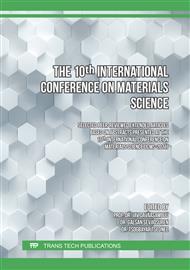p.1
p.15
p.21
p.29
p.39
p.49
p.63
FTIR Study of Enriched Bituminous Ukhaa-Khudag Coal
Abstract:
In the present work we pay an attention to the molecular structural changes between raw coal and its enriched, dense productions. Bituminous Ukhaa-Khudag coal in the form of an enriched, dense coal product is currently used as an energy source by Mongolian consumers for everyday need. There are three types of samples from one source: it is a raw coal (sample 1) and two of industrial prod- ucts as an enriched, dopant (organic based) added coal (sample 2) and simply enriched coal (sample 3). The raw coal general characterization is given through the elemental analysis, thermogravimetry analysis, moreover functional groups were identified by Fourier Transform infrared spectroscopy. The differences in the FTIR spectra of the samples were done.Some details are as follows: hydroxyl group vibrations are existing, rather weak in agreement of TG result; vibrations of aliphatic group were rarely in the long wave near region, carbonate minerals in the region of 1300-900 cm−1 are visible but overlapped, and an isolated out-of-plane deformational vibration (around 800 cm−1) or two-adjacent (800-750 cm−1) or three-adjacent (around 700 cm−1) of sp2-hybrid bonded aromatic CHx-groups were still presenting.After the processing hydroxyl group bands were affected in enriched coals, sample 2 and 3. In the spectrum of the sample 2 the long wave bands were intensively blurred.Industry processing retains an amount of water in the productions. Water excess influenced absorbance bands were able to be removed via the drying processing, however, the affection to the spectral struc- ture in sample 2 was unrecoverable.
Info:
Periodical:
Pages:
63-70
Citation:
Online since:
April 2023
Keywords:
Permissions:
Share:
Citation:



